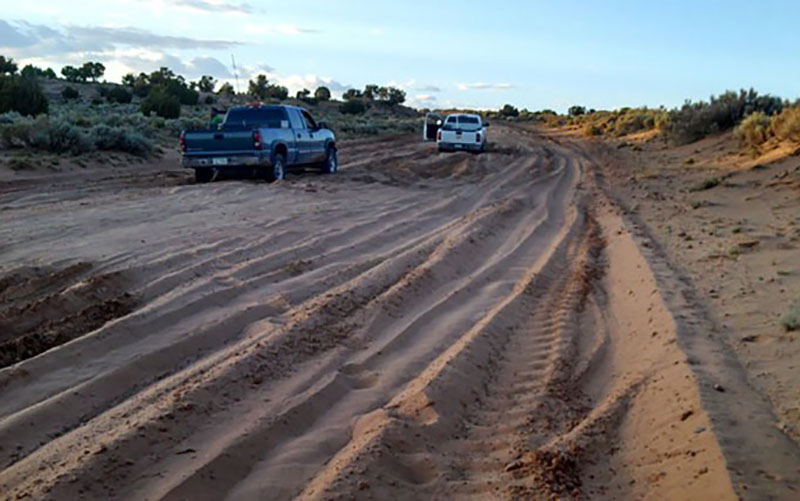
Many of roads in tribal areas, like the Navajo Nation, are unpaved and become unpassable during bad weather, which is why roads are just one of the targets of the Biden administration’s infrastructure plan. Native Americans have been on “the short end” of infrastructure investment over the years, an administration official said. (Photo courtesy Navajo County Public Works Department)
WASHINGTON – Indian Country infrastructure needs, for everything from water to housing to broadband, are a high priority of the Biden administration’s $2.2 trillion American Jobs Plan, Transportation Secretary Pete Buttigieg said this week.
Buttigieg, in a call with reporters Monday to discuss the plan, said the need to improve 20th-century infrastructure on the lands of the 574 federally recognized tribes has been ignored by the federal government for years.
“A lot of parts of Indian country have been on the short end of … infrastructure investment maintenance, over the years,” Buttigieg said.
The American Jobs Plan is President Joe Biden’s $2.2 trillion plan to transform the nation’s infrastructure. Along with the American Rescue Plan, which aimed to help Native Americans recover from the COVID-19 pandemic, the administration intends for the American Jobs Plan to help solve the tribes’ growing infrastructural needs.
“When we talk about equity, we’re thinking a lot about racial and economic justice,”
Buttigieg said of the plan. “But we’re also thinking about stretches of this country that have too often been left out of the promises of this kind of great infrastructure.”
For Native American communities, those needs include critical water infrastructure, internet broadband, housing, transportation, tribal colleges and universities and roads, Buttigieg said.
Broadband was among the top priorities for tribes with the American Rescue Plan, which funding to come from the Department of Housing and Urban Development. Many families did not have access to the internet throughout the pandemic, making it difficult for their students to attend distance learning classes.
Biden’s infrastructure plan aims to provide 100% broadband coverage across rural and tribal communities.
“The lack of access to broadband on tribal lands is particularly severe,” said Bharat Ramamurti, deputy director of the National Economic Council. “There’s going to be a significant tribal component to that.”
The American Jobs Plan also aims to inject funding into research and development programs for colleges and universities across the nation, including tribal. But Monte Randall, president of the College of the Muscogee Nation, believes broadband access is still the top concern for his students.
“There are definitely challenges with connecting to our students on virtual platforms,” Randall said. Many College of the Muscogee Nation students live in rural areas where internet access is not available.
The school received funding from the Higher Education Emergency Relief Fund in the CARES Act, the first pandemic-relief bill approved last year, to provide students with laptops and internet hotspots, but lack of internet access is still the biggest challenge.
The College of the Muscogee Nation is primarily focused on natural resources programs, but Randall said the funding for land grants and research and development programs at tribal universities would help his school “move towards being more research-focused.”
Tribes nationwide are already set to receive $651 million for housing from the American Rescue Plan, as well as $450 million in tribal housing assistance. Ramamurti said the American Jobs Plan will fix the lack of affordable housing, as well as upkeep of existing housing on tribal land.

Reels of cable sit along a Montana highway in this 2016 file photo. Broadband internet access is one of the top priorities for rural and tribal areas. (Photo by Tony Webster/Creative Commons)
“The lack of affordable housing … is a nationwide problem and particularly severe on tribal lands,” he said. “There is also a specific problem with preservation and rehabilitation of existing housing on tribal lands, and so the housing components of the plan are focused on that area.”
Buttigieg stressed the importance of a robust transportation system in tribal and rural communities, which often are isolated from important resources.
“Transit, which I know people imagine is big-city, but can be very important in a lot of counties,” Buttigieg said. “A transit system is an important part of helping people get around, it’s the same in Indian country.”
The rural and tribal fact sheets the administration provided on the American Jobs Plan said it will “more than double the Tribal Transportation Program to provide safe and adequate transportation and public road access to and within tribal areas.”
Ramamurti agreed with Buttigieg that it’s time for the federal government to step up and invest in Native American communities.
“When it comes to infrastructure, the problem on tribal lands are particularly severe, reflecting, frankly, years and decades of underinvestment by the federal government,” he said. “And I think part of what we’re trying to do here, is address that.”
Gaylord News is a reporting project of the University of Oklahoma Gaylord College of Journalism and Mass Communication. Cronkite News has partnered with OU to expand coverage of Indigenous communities.
